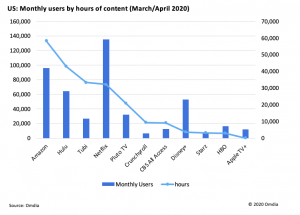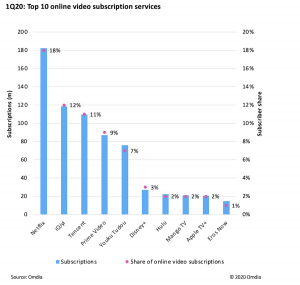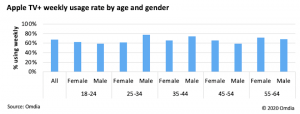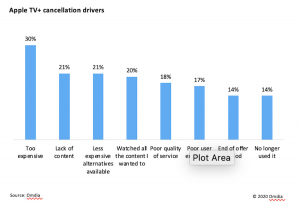TBI Tech & Analysis: Reflecting on Apple TV+ one year in
Apple TV+ might have the world’s most expensive company behind it, but intense competition in the streaming world means there is no guarantee of success. Fateha Begum, principle analyst at TBI sibling OMDIA, tells Richard Middleton how the service has fared as it celebrates its first birthday.
One of the most-talked about recent entrants to the online video sector has been Apple TV+, which has seen high uptake since launching in November 2019, primarily driven by its device bundle.
The service comes at a monthly price of $4.99 or a year’s free trial with a qualifying Apple device purchase from September 2019, while content includes Reese Witherspoon and Jennifer Aniston’s drama The Morning Show, Anonymous Content’s scripted series Dickinson, and Victoria Stone and Mark Deeble’s doc The Elephant Queen.
As the streamer marks its first birthday, here are six takeaways from Omdia’s bi-annual consumer survey (April 2020) that illuminate where the nascent service sits in the increasingly crowded global OTT ecosystem.
Omdia estimates that the service had accrued nearly 21 million subscribers globally by the end of Q1 2020, of which 93% were coming via the device bundle, so not generating any direct subscription revenue for Apple. Its relatively low price and device bundle has led to high customer acquisitions, making Apple TV+ the ninth largest online video service globally for subscriptions. However, as most Apple TV+ subscribers are non-paying and the service continues to have a relatively limited catalogue (more of that later), customer retention will be a challenge. In October, Apple announced the extension of its year’s free trial to February 2021, as well as the launch of Apple One, which bundles a number of Apple services, including Apple TV+, at a discount price.
Premium picks…
Apple TV+ launched with a ‘premium’ content offering, focusing on fewer titles but of higher quality compared to competitor services. However, while exclusives and originals drive uptake, Omdia’s survey findings reveal that ‘range of content’ is the most cited subscription driver for video services. Although Apple doubled the number of titles in its first five to six months since launch, its total catalogue size lags behind that of its rivals. Despite its relatively low price, a larger catalogue size will be vital in warding off churn, particularly as existing subscribers come to the end of their year’s free trial. Apple’s shifting focus on services come in a bid to lock customers into its ecosystem – a move Apple has successfully built on over the past decade. Apple’s hardware business continues to be its biggest revenue stream. However, the launch of Apple TV+ on other devices also signaled a big change in the tech giant’s strategy, as it recognises the importance of ubiquity to gain wide adoption in a world where consumers expect access to services across devices and platforms.
 …and a reduced reliance on range
…and a reduced reliance on range
As mentioned above, when it comes to all subscribers, range of content is the biggest subscription driver with 42% selecting it across all video services. However, this falls to 14% when looking at reasons for subscribing to Apple TV+ specifically, which ties in with Apple’s content strategy. Consumers that select range of content are more likely to subscribe to Netflix (68% vs. 50%) and Prime Video (47% vs. 35%) than the average consumer. Apple TV+ subscribers are more likely to indicate they subscribe to Prime Video for its range of content over its wider benefits, suggesting Apple TV+ subscribers are driven by content needs more than bundled offers. This would bring good news to Apple as its free bundle comes to an end; however, lack of content remains a challenge.
Content comparisons
In March (around the time of the consumer survey), Apple TV+ had 13 shows available on the platform according to Omdia’s titles tracking partner in the US. At an average of eight episodes per series, this equates to just over 100 unique episodes and 67 hours of content. Although this is double the number of episodes since launch, Apple TV+’s catalogue is significantly behind that of competitors. By comparison, Disney+ launched in the US around the same time, and offers more than 50,000 hours of content. In April 2020, 67% of Apple TV+ users claimed to use the service at least once a week. Assuming no further titles are added, it will take the average weekly user approximately 15 weeks to watch the entire catalog on offer. Apple TV+ is positioned as a premium content platform, but its lack of titles and low refresh rates will be a major churn driver at the end of the free offer period. Consumers want range of content, more so than originals and exclusives – the latter as a subscription driver are not sustainable. This is a particular concern in the US where previous research indicates that online video consumers are more likely to engage with a high number of TV series across multiple video services on a weekly basis.
Usage of Apple TV+ falls significantly when comparing all users to those that subscribed for a free trial and purchased an iPhone 2019 onwards. Of the latter group, nearly one in four indicated they use the service less than once a month or never. More than half of Apple TV+ subscribers are aged 18 to 34, however, in terms of usage rates, it is older age groups that show higher engagement. This is particularly the case for female subscribers who are more likely to access the service once a week or more. Daily usage rate is highest among females aged 35-44 at 45%, compared to 36% for males in the same age bracket and 31% of all subscribers. Apple TV+ subscribers however are generally more engaged with video services than the average consumer. In an average month, Apple TV+ subscribers watch video content on 12.8 video services, compared to 6.8 among all online video subscribers and 5.5 among all consumers surveyed.
Despite the majority of Apple TV+ uptake being driven by the device bundle, the video service is seeing high churn across markets. 58% of those cancelling Apple TV+ claim to have used the free trial only. Consumers in Japan, the US, and the UK are most likely to have subscribed to the service for its free trial. Among those cancelling the service and not returning, churn drivers vary by market. “Too expensive” and “lack of content” are the biggest churn drivers of Apple TV+; the two factors go hand-in-hand as content helps to drive value of service. In Brazil, 40% claimed they cancelled as they no longer used the service. Generally, price is the biggest driving factor of churn in the market. In Germany, 1 in 2 of those cancelling Apple TV+ indicated it was due to a lack of content. Lack of content is a major churn driver driving 31% of cancellations, second to “too expensive” at 37%.
Fateha Begum is principal analyst for consumer devices & media at OMDIA, the global technology research powerhouse which, like TBI, is part of Informa. The data above comes from her recent report, Apple TV+: Users and Device Ecosystem, which is based on OMDIA’s bi-annual consumer survey from April 2020 which focused on the US, Brazil, UK, France, Germany, Japan, and India.









